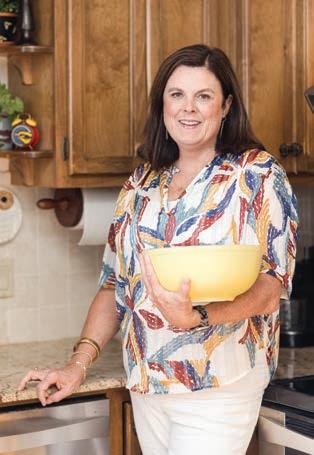
15 minute read
BAY TABLES
Work: Assistant Professor of B.'/(),04<2#(3'0)(,4%+5%6+7(8' Kids: Two, ages 4 and 6 Home: West Mobile
!"#$"%&'#()'%*+#')%,'"-.')%"#$% /'#,+0)%),1$'#,)%",%,.'%2#(3'0)(,4%+5% 6+7(8'9%:)%"#%"))(),"#,%;0+5'))+0%+5% -.'/(),04<%.'0%$"4)%(#3+83'%'=;8"(#> (#?%-+/;8'=%5+0/18")%"#$%(#,0(-",'% directons. So when she gets home afer the grind and needs to feed her two young boys, she is looking to do )+/',.(#?%)(/;8'0%"#$%8'))%$'/"#$> ing. As a foster and adoptve parent, Jones wants to spend as much tme with her boys as possible, rather than cooking. “I do major meal prep on Fri> days and Sundays, so during the week I can have everything ready in 30 min> utes.” Although she likens being in the kitchen to being in her chemistry lab, the end product is a litle difer> ent. Sheet pan fajitas, baked chicken and spaghet are weeknight staples, and once a week the family splurges on quick takeout. She also says the slow cooker does some heavy lifing at her house. Wanda credits Fostering @+?',.'0%A185%B+"),%5+0%7'(#?%.'0%)1;> port on this journey of being a single, working mother. “Mobile has proven to be a family-friendly city, and I love -"88(#?%(,%.+/'9C
Advertisement


WANDA’S BBQ BACON MEATLOAF MUFFINS
SERVES 4
1 teaspoon olive oil 1/2 cup Pictsweet Seasoning
Blend (frozen, chopped mixture of onions, celery, green and red peppers and parsley flakes) 2 pounds lean ground beef or ground turkey 2/3 cup hickory barbecue sauce 1 1/2 cups bread crumbs 2 eggs, beaten 1/3 cup finely chopped bacon 1 packet dry onion soup mix 1/2 cup shredded cheddar cheese
1. Preheat the oven to 350 degrees. Lightly spray a 12-cup muffin pan with nonstick cooking spray. 2. In a medium sauté pan, heat olive oil over medium heat. Add chopped vegetable mix to the pan and sauté until lightly browned and tender, about 3 minutes. 3. In a bowl, combine the ground beef with 1/2 cup of barbecue sauce, bread crumbs, the beaten eggs, bacon, onion soup mix and 3/4 cup water. 4. Add the sautéed vegetables and mix until blended, being careful not to over mix. 5. Pack the meat mixture into the prepared muffin cups and bake for 20 minutes. 6. Remove from oven, brush with remaining barbecue sauce and return to oven for 5 to 10 minutes. Serve warm.
Wanda serves her meatloaf muffins with broccoli and mashed potatoes. They can also be prepared ahead and frozen before cooking. Just bring to room temperature before cooking and serving. Work: Pre-K Teacher, hrist the King 9*-"&.16$26"&&. Kids: Seven, ages - 3 Home: aphne

!"#$%&'()*+$,-*'-,$#*'.+$/&'$0&,1#$ 2%*3,&34$!"1,$5'#,6"&&.$-#*6"#'$*'7 '18#,$*-$9"'1,-$-"#$:13;$13$5.#3-+$&/$ tme for other parents to drop their kids of on the morning commute. And the afernoons don t slow down, either. As a mom of seven herself, there is no shortage of homework, actvites and sports to coordinate. It s a good thing she is well orga7 31<#)$*3)$"*,$*$=*'+$>&5513,75&,17 tvity that is contagious. osie loves to cook, so a more involved recipe doesn t intmidate her, but weekly meal planning and organi ing ingredi7 ents daily keeps her moving forward. The kids help with the planning, chim7 ing in on what sounds good, but osie doesn t mind, claiming they have adventurous palates. “A salad is al7 most always on the menu, too. ou can be creatve and there is no cook7 ing involved, just washing, chopping *3)$5'#5513;4?$2"#$1,$*.,&$(3&%3$-&$ make her own salad dressings. Week7 nights revolve around her big kitchen island, where kids do homework and visit all together. She says it s hard to nd healthy takeout optons, but Sec7 ton Street Pi a afer a long week is a well-earned guilty pleasure. Visit mobilebaymag. com for Rosie’s Mango Salsa recipe!
BLACK BEAN AND SILVER QUEEN CORN QUINOA SALAD CUMIN LIME DRESSING
SERVES 6
1 cup uncooked quinoa 1 can black beans, drained and rinsed 1 medium colored pepper, chopped 1/2 cup chopped red onion 1 1/2 cups Silver Queen corn kernels, cut off the cob 3/4 cup flat leaf parsley, chopped 1/2 cup cilantro, finely chopped 1-8 ounce can chopped mild green chilies 1 bunch curly green kale, tough ribs removed and chopped small (3 cups) salt and pepper, to taste Cumin Lime Dressing (recipe right) 1/3 cup crumbled cotija or feta cheese 1/3 cup toasted pepitas
1. Cook quinoa according to package directions. When ready to use, fluff with a fork. 2. In a large mixing bowl, combine all remaining ingredients, except dressing, cheese and pepitas. Salad can be made ahead and refrigerated overnight until serving. 3. When ready to serve, toss salad again, top with cheese and pepitas and serve alongside Honey Lime Shrimp Tacos.
An avid cook, Rosie often makes tortillas from scratch. Weeknights, however, call for something quick from a package. These store-bought almond flour tortillas are preservative-free and feel homemade.
MAKES 1/2 CUP
1/4 cup olive oil 3 - 4 tablespoons lime juice 3/4 teaspoon ground cumin 1/8 teaspoon smoked chipotle powder 1/2 teaspoon salt, to taste
1. Combine ingredients in a small bowl and whisk well.
HONEY LIME SHRIMP
SERVES 6
1/2 cup lime juice (4 - 6 limes) 1/2 cup honey 2 cloves garlic, minced 1 teaspoon freshly ground pepper 1/2 teaspoon smoked paprika 1 teaspoon salt handful of cilantro, chopped 1 tablespoon olive oil 1 1/2 pounds shrimp, peeled and deveined *
1. Combine all ingredients except shrimp and oil in a medium mixing bowl. Mix well. 2. Whisk in oil and adjust seasonings to taste. Pour half the marinade mixture into a large zip-top bag and set the remainder aside. Add shrimp to bag and toss to coat. Seal and place in refrigerator for 15 - 30 minutes. (Do not exceed 30 minutes.) 3. Preheat a grill pan or outdoor grill. Thread shrimp onto wooden skewers and grill for 2 - 4 minutes on one side. Turn and baste with remaining marinade. Grill for another 2 - 3 minutes, or until opaque and cooked through. * You can substitute pork tenderloin or chicken breast for the shrimp. Increase cooking time for each protein.

G+03Q'J,,",/*#/'R4&*7'B+1#,47<' I#"940,"/.'+5'8+1/)'J7*;*$*'C4*7/) M"-,Q'@D+<'*&4,'S'*#-'T C+$4Q'8>0"#&'C"77 !"#"$"%"#&'()*+,'+#'!+#-*.'/)0+1&)' 20"-*.'",'34.'5+0'617"*'8)0494'*#-')40' 5*$"7.:'8)4'*#-')40')1,;*#-<'=+;40/<' are both busy atorneys, and so all the &0+(40.',)+>>"#&'*#-'$4*7'>04>'",' done on weekends. Keeping a routne )47>,'$4*7'>7*##"#&<'/++'?'$4*/74,,' !+#-*.,<'/*(+'@14,-*.,A'.+1'&4/'/)4' "-4*:'B++3"#&'"#'/)4'04$+-474-'3"/()A 4#'+5')40'8>0"#&'C"77')+$4'",'#4940'*' ()+04<')+D4940<'/)*#3,'/+'/)4'-4,"&#A 40,'+5'!*0()'E'!*.:'FG4'7+94'+10' #4D'#4"&);+0)++-<'/++<H',)4',*.,<' F*#-'D*73"#&'$.',+#'*#-'-*1&)/40'/+' ,()++7'",'$.'5*9+0"/4'>*0/'+5'/)4'-*.:H' 617"4'(*#';4'5+1#-'*#.D)404'50+$' I8J'B)"7-04#K,'*#-'G+$4#K,'/+'I#"A 940,"/.'C+,>"/*7<'+#'(*$>1,'+0'"#'(7"#A "(,<'',+'D+03-*.,'(*#';4'*'(01#():'J,' a transiton from work to family tme, ,)4'4#-,'/)4'D443'D"/)'/*34+1/'50+$' @%*%"3"K,'+0'L*3'/)4'M*/)$*#-1'M"/()A 4#:'FN')*94'*'0174'/)*/'N'-+'#+/'(++3'+#' 20"-*.'#"&)/,:H'J#-'617"*'*-$"/,'-"##40' ",#K/'*7D*.,',+$4/)"#&'(+$>74O'+0' )+$4$*-4:'FJ'7+/'+5'#"&)/,'D)4#'$.' )1,;*#-'*#-'N'*04')*9"#&',+$4/)"#&' $+04'*-94#/10+1,'5+0'*-17/'/*,/4,<'+0' 494#'P1,/',*7*-,<'/)4'3"-,'4*/'()"(34#' #1&&4/,<')+/'-+&,'+0'&0"774-'()44,4:' Some nights pushing the easy buton is the best opton for all ”


Work: 6+3%+,,$%+3( and onstructon Management Kids: Two, ages and Home: Midtown Mobile
!"#$%&'()*$+,("+-(.%/(0"1%2*("$,($,345 lars at the ball eld, the ballet studio and Mobile Tennis enter. Juggling two kids actvites with work and community involvement is always a challenge, but Patrick and wife aro5 lyn have perfected the art of lastminute dashes to the midtown Publi for recipe ingredients. Me ican food makes a weekly appearance, and on nights they are too busy to cook, it s usually Taco Mama followed by a treat from ammie s ld utch. He claims they are dying to renovate their kitch5 en, but any needed improvements don t stop him from whipping up a mean batch of spaghet, burgers or this easy slow cooker dinner. This Mobile natve and Sewanee grad has worked in the engineering and con5 structon management industry for the past years. He says there is no place like his midtown neighborhood. “We live on a dead-end street, which we love because it cuts back on tra c and allows our children to safely play outside. It also brings all the neigh5 bors close together, so we look out for one another.” ut the best kind of neighbor is one who shares his best recipes.



a
Ask the adults with gray in their hair. The ones who were pie-eyed, baseball-loving kids in that sprawling city of subways and fasttalking swagger back in 1969. They all knew Cleon Jones. He was the sweet-swinging hero of the 1969 New York Mets — dig that .340 average — who made, perhaps, the coolest last out in World Series history. As Davey Johnson’s towering fly ball fell to earth, Jones secured it in his mitt and knelt down, an unintentional genuflect to the Mets’ improbable one-year journey from lovable doormat to baseball.
Books about the “Miracle Mets,” as the 1969 team has come to be called, practically constitute their own section at Barnes & Noble. Jones’ memoir, “Coming Home: My Amazin’ Life with the New York Mets,” is the latest — and Jones’ second title. He penned a post-championship autobiography in 1970.
“Coming Home,” to be released on August 2, will satisfy fans of the perpetually doomed baseball team. They will learn of Jones’ ups and downs as one of the franchise’s best, if not most overlooked, players. They’ll also learn about Plateau, Alabama, where Jones was born and raised about 5 miles north of Mobile. What’s missing from the book is New York. There are no stories of Jones outrunning the night, no encounters with the city’s hip movers and shakers, not even a mention of how the pizza tasted.
New York was where he worked, but he always returned home — to the place he called Africatown. One reason was obvious. The other took time to emerge.
“The picture is becoming clearer as to why I’m here and what I’m doing,” Jones says. “It doesn’t have a thing to do with me being on the front page or me being in charge. Somebody has to do the work. Someone has to be the bearer of the torch.”
History and baseball and hometown pride are like the seams of a baseball — they run through Jones’ soul, seemingly with no beginning or end.
For Love of the Game
As a boy, fishing with his grandmother, Mama Myrt, Jones heard stories about the Clotilda, the last known slave ship to reach the United States. Africatown was settled by the ship’s survivors after the Civil War. The stories stuck with young Cleon, as did the fact that the word “slaves” never left her lips. It was Jones’ grandmother and great-grandmother, who raised him, who also inspired his love of baseball. The family would sit, transfixed, around the massive radio, listening to the Brooklyn Dodgers. Jones remembers his grandmother yelling at Jackie Robinson to avoid a head-hunting pitcher.
“That enthusiasm just rubbed off on me,” Jones says.
His community had a love for the diamond. The place teemed with large families
when Cleon was growing up. He fondly recalls how he’d go outside with a mitt and a ball and within minutes, a game, nine to a side, would start. It didn’t matter how hot the weather was. The players would imagine themselves as the stars of the day: Mickey Mantle or Ted Williams or Mobile native Henry “Hank” Aaron. “We idolized all of them,” says Jones, who most often opted for Aaron or Willie Mays.
In Africatown, like Mobile, baseball ruled. In the 1940s and ’50s, Black players, such as Larry Doby and Robinson, served as avatars of hope for young Blacks in the South.
At that time, the NFL and NBA were in their infancies, and baseball was truly the national pastime. Its roots ran deep in the Mobile area, extending well beyond Satchel Paige, the god-like Negro League pitcher and barnstormer who played well into his 50s. According to baseball historian James E. Brunson III, author of “Black Baseball, 1858-1900: A Comprehensive Record of the Teams, Players, Managers, Owners, and Umpires,” the earliest record of a uniformed Black baseball team in Mobile is the Union Stars in 1868. Baseball’s presence in the South boomed after the Civil War. Brunson has a theory: The game was played on plantations. Some of these former slaves then became barbers, who frequently organized ball clubs, or worked at resort hotels that hosted white and Black ball clubs.
Jones heard the stories. He knew the names. And there was support. “You were encouraged by so many people, in so many ways, because everyone had an interest in one another,” he says. Coach James “Fat” Robinson, who worked at Brookley Field,
would come by after his shift with balls, bats and gloves so the kids could work on their skills. “The old men of the neighborhood,” talented local ex-ballplayers also offered pointers and spurred Jones on.
Jackie Robinson and Doby (the American League’s first Black player) proved to be exceptional. By Jones’ time, opportunities in the majors abounded for Black ballplayers so Jones wasn’t too surprised to sign a big league contract. The talent level when Jones, born
“HOME WAS ALWAYS THE DRIVING FORCE FOR ME. TO ME, HOME MEANT FAMILY, AND MY WHOLE COMMUNITY WAS MY FAMILY. I NEVER HAD THOUGHTS OF WHETHER I WOULD FAIL BECAUSE I WAS REPRESENTING A COMMUNITY
THAT HAD BEEN SO SUPPORTIVE OF ME AS AN ATHLETE — A SON OF THIS NEIGHBORHOOD.”
- CLEON JONES, IN AN EXCERPT FROM “COMING HOME: MY AMAZIN’ LIFE WITH THE NEW YORK METS”
in 1942, grew up was unreal; he wasn’t even the best athlete on the block.
In Mobile, major leaguers became a major export, led by Aaron and Willie McCovey. Billy Williams, another Hall of Famer, was like a brother to Jones. He married a girl who lived on Jones’ street. “Keep going,” Williams told him, “scouts are watching.”
The late Tommie Agee and Jones had been classmates at Mobile County Training School. Years later, they were teammates — and roommates — on the Mets. (Agee made two memorable, game-saving catches in Game 3 of the 1969 World Series.) Amos Otis lived with Jones and his wife, Angela, when he made the bigs. Otis later became an All-Star with the Kansas City Royals.
Jones recalls that those players became a support system that many of the original Black titans of sport didn’t have in the beginning. “The Js” — Robinson, Jesse Owens and Joe Louis, as Jones calls them — had been isolated. “But we were there for each other,” he says. For example, Jones talked with Jackie Robinson and comforted Aaron when he faced death threats in his chase to eclipse Babe Ruth’s all-time home run record. “We could support one another and critique one another. Those guys didn’t have anyone … That’s what made it diffi cult.”
Sliding into Home
Although baseball is still very much a presence in Mobile, in many ways, the culture has changed. Sure, kids play in the organized leagues now. But baseball is not intricately linked with Mobile anymore. It’s not part of the town’s identity. Jones saw the change early in Africatown. The population plummeted. His son would go out with a glove and ball, and only the sun would join him.
Shadrach Collins Jr., the City of Mobile’s 50-year-old superintendent of recreation, says baseball was still the dominant sport in Mobile during his youth. Not anymore. Baseball equipment costs too much; travel teams have taken over. There’s a lack of good coaching.
Today, Cleon Jones is 80 years old and still calls Africatown home. He’s a former All-Star and a key fi gure on one of the most storied baseball teams of all time. He hit .300 in the big leagues, something only the truly great accomplish.
Kids know him as the guy who cleans up his neighborhood, but “they have no idea what this man has done,” Collins says.
That’s fi ne, Jones responds with equanimity. That’s what Google is for.
As a kid, Jones wanted to be a baseball player. When that happened, Jones wanted to pay Africatown, “the greatest place in the world,” back for its support. Collins was a recipient of that generosity as a youngster. One day, he and his dad ran into Jones outside of JCPenney.
“Hey, Cleon, how can I teach my son hit the curveball?”
“Throw bottle tops to him. Have him hit ’em with a broomstick. The ball will look like a balloon.”
Jones wants people to see Africatown with that clarity. He wakes up early each day, ready to go, making sure houses get repaired, cutting grass, attending meetings and fundraisers. He’s hosted a youth baseball clinic. Another Mobile ballplayer, 2007 National League Cy Young Award winner, Jake Peavy, helped out. Jones also rallied support for a Walk of Fame honoring Mobile’s sports stars. His success as a player then, Jones says, set up what he does now. It’s all part of God’s plan, he says, but work still remains.
“What I see in Africatown, most people can’t see it,” he says. “I remember when there wasn’t a vacant lot in the whole community. I remember when there were 17 mom-and-pop stores in the community that sent their kids to college. That’s what I see. I see the family unit, and I see kids fl ourishing from the proper education, church values. When I came up, that’s what you had to have. If you didn’t go to church on Sunday, then you got in trouble in school on Monday. Family values were passed down to the community. That happened during my time. Ten years later, 15 years later, it wasn’t the same.”
The person who drives through Africatown and throws a fast food bag out the window doesn’t get that. So Cleon Jones, out on his tractor, picks it up. He’s determined to accomplish the vision he sees for his hometown — the reality he and his grandmother and great-grandmother cherished. MB
WHAT I’M DOING. IT DOESN’T HAVE A THING TO DO WITH ME BEING ON THE FRONT PAGE OR ME BEING IN CHARGE. SOMEBODY HAS TO DO THE WORK. SOMEONE HAS TO BE THE BEARER OF THE TORCH.” - CLEON JONES


“Coming Home: My Amazin’ Life with the New York Mets” By Cleon Jones, written with Gary Kaschak, $30, Triumph Books
Pete Croatto’s sports writing has appeared in The New York Times, The Athletic, The Toronto Star and many other publications. He is the author of “From Hang Time to Prime Time: Business, Entertainment, and the Birth of the Modern-day NBA.”









